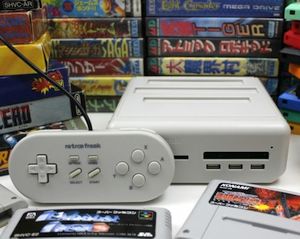Most Recent: Retro
The Video Game Canon: Super Mario 64

Dig deeper into the Video Game Canon with an exploration of all the ways Nintendo tried to teach the world about 3D games with Super Mario 64. Here’s a teaser…
For Mario’s first foray into “The Third Dimension,” Nintendo wanted to ensure that everything was perfect. In fact, the Nintendo 64, its unique three-pronged controller, and the controller’s analog stick designed to better simulate 3D movement were all created with the needs of Super Mario 64 in mind.
Nintendo had good reason to be worried about getting all of the details just right, as most video gamers had never even seen a 3D platformer before Super Mario 64. Aside from a few experimental titles from the late 80s and early 90s, 3D movement was only found in a handful of titles on the market at the time, the most famous of which was probably EA’s Fade To Black. Naughty Dog’s Crash Bandicoot, which included pseudo-3D movement, beat Super Mario 64 to store shelves by about five weeks, but a majority of the game took place on a 2D plane.
So Nintendo used Super Mario 64 as an opportunity to introduce players to what was, in their mind, an entirely new genre. Shigeru Miyamoto’s exacting attention to detail helped mold every part of the game. The first interaction players had with the game was the appearance of an actual cameraman (Lakitu the Cloud), and instructions on how to control the camera’s angle with the diamond-shaped set of C-Buttons on the right side of the Nintendo 64 controller.
Actually, let me back up… the very first thing most players experienced after booting up Super Mario 64 was the interactive Mario face on the Title Screen. Miyamoto saw fit to even offer players a primer on polygons as the squares, rectangles, and rhombi that made up Mario’s face could be grabbed and manipulated in dozens of different ways. In a way, “It’s-a me, Mario! Hello!” was a coded message that encouraged players to jump right into this new 3D world.
Visit VideoGameCanon.com to continue reading this article and to explore the complete Top 1000.
“12 In 1” Retro Freak console launches exclusively throughout Europe
 Those of us big on retro gaming had many consoles to play with before today including the RetroN 5, the RetroDuo, the SupaBoy, and the NES Classic Edition. But now, the retro gaming community can add another console to the list, the Retro Freak.
Those of us big on retro gaming had many consoles to play with before today including the RetroN 5, the RetroDuo, the SupaBoy, and the NES Classic Edition. But now, the retro gaming community can add another console to the list, the Retro Freak.
Sold exclusively throughout Europe at FunStock, the Retro Freak is a “12 In 1” retro gaming console that allows you to play all of your favorite classic video games from the PC Engine, TurboGrafx-16, Super Grafx, NES, Famicom, SNES, Super Famicom, Sega Genesis, Sega Mega Drive, Game Boy, Game Boy Color, and Game Boy Advance. This is a big step up from other competing retro consoles, which tend to offer support for just the big three (NES, SNES, and Sega Genesis).
While that list doesn’t quite include all of the consoles from the 80s and 90s, it does account for the major players and a few of the lesser known, but equally fun, ones.
Adding to the Retro Freak’s cool factor is the ability to play emulated games stored on an SD card. So if you don’t have a physical version of the game, you can still play it so long as the (often less-than-legally-obtained) file is present on an SD card. With that same SD card, you can save your game’s progress, and pick up where you left off later.
The Retro Freak comes with a SNES style controller, a three pin UK plug and an EU two pin plug. The Retro Freak also features an HDMI output with HD upscaling capability, advanced emulation options such as cheats and multiple save states, and upgradeable firmware.
Interview: Serving Up Conversation About Joysticks, Pints, and Kickstarter With the Owner of Glasgow’s First Arcade Bar

One of the rare delights of following projects on Kickstarter is when you spot someone trying to build something in your own town or city, be it a video game, an album, a film, or, in this case, a bar. There is an instant, and intimate, connection of homegrown pride and creative curiosity. That’s especially true after Super Bario popped up on my radar late in its campaign.
For my sins, I never contributed to Super Bario when the project was live, despite my love of both video games and tasty craft beer. The arcade bar occupies a small space on King Street in Glasgow, Scotland, in an area teeming with art and creative spirit. It backs onto the Tron Theatre, while directly opposite there is Trongate 103, home to Glasgow Print Studio, Street Level Photography, and the Sharmanka Kinetic Theatre.
I have now become a patron of the bar, and try to pop in when I can, enticing friends who love video games, or those who remember being a kid standing before that monolith of entertainment… a cabinet of wood and a CRT display flickering sprites into our awestruck eyes.
Super Bario has proven to be a great success, a space for gamers to chill and enjoy a drink while sucking in the sweet smell of nostalgia. Amidst the craziness, I managed to chat with co-owner Shaun Murawski, who along with Scott McLauchlan and George Black, conceived of the arcade bar back in 2015, and fought hard to make it a reality with the backing of 166 donors. (more…)
Video Game History Foundation wants to create a digital record of the industry’s past
Frank Cifaldi is a developer who has worked on Mega Man Legacy Collection and IDARB, but he is also the founder of the Video Game History Foundation, a new non-profit that seeks to preserve and digitize the history of video games.
The Video Game History Foundation launched their first “Digital Collection” yesterday, focusing on The NES Launch in 1985. Cifaldi is also seeking donations to expand the scope of the Foundation, as detailed on their “What We’re Doing” page:
The heart of the Foundation is its digital library, an online repository of artifacts related to the history of video games and video game culture. The ultimate goal is to create a searchable, organized, always-online archive of verified, high-quality material that is accessible to researchers and historians as a public education resource.
All donations to the Video Game History Foundation are tax deductible, and I can’t wait to see what collections they come up with next.
First poster from Netflix’s Castlevania series revealed by Producer Adi Shankar
 A Castlevania television series will make its way to Netflix this year, and Producer Adi Shankar recently revealed the first poster for the animated adaptation on his Facebook page. We still don’t know when the series will debut, but the gothic vibe that Shankar is going for is certainly evident in this image.
A Castlevania television series will make its way to Netflix this year, and Producer Adi Shankar recently revealed the first poster for the animated adaptation on his Facebook page. We still don’t know when the series will debut, but the gothic vibe that Shankar is going for is certainly evident in this image.
According to Netflix, the first season will be comprised of four half-hour episodes:
Inspired by the classic video game series, Castlevania is a dark medieval fantasy following the last surviving member of the disgraced Belmont clan, trying to save Eastern Europe from extinction at the hand of Vlad Dracula Tepe himself.
Based on Castlevania III: Dracula’s Curse, the Castlevania series will be written by Warren Ellis, and a second season is said to be in production for release in 2018.
The Video Game Canon: Halo: Combat Evolved

Dig deeper into the Video Game Canon with a look at Microsoft’s first attempt to enter the console market and the birth of Halo: Combat Evolved. Here’s a teaser…
Microsoft is usually portrayed as the stodgy suit in contrast to Apple’s hip turtleneck, but would you believe that the first Xbox prototype was built on a whim by a quartet of guys from the company’s engineering department?
Kevin Bachus, Otto Berkes, Seamus Blackley, and Ted Hase first took their “DirectX Box” to Ed Fries, the head of Microsoft’s video game division, in 1998. Even though everyone in the world had played a dozen hands (or more) of Windows Solitaire, Microsoft wasn’t a big player in the game development arena at the time. Similar to today’s line of console-like PCs, the original “DirectX Box” was an off-the-shelf Windows PC with a video card and a hard drive that hid the Windows-ness of the system from the player.
Before the “DirectX Box” could move forward, Fries and his team had to fight off a challenge from a separate team within Microsoft that had worked with Sega to produce some of the system software for the Dreamcast. They were pushing for the company to create a more traditional console (no Windows, no hard drive), and Bill Gates himself ultimately stepped in to give his blessing to Fries and his “DirectX Box.”
[…]
[Eventually,] Microsoft toted their Xbox prototype, which was a massive X-shaped silver box with a glowing green core, to the 2000 Game Developers Conference, and officially announced their intention to take over the living room (with an assist from Bill Gates and Dwayne “The Rock” Johnson). A few months after that, the company purchased Bungie Studios and their upcoming game, Halo: Combat Evolved.
Visit VideoGameCanon.com to continue reading this article and to explore the complete Top 1000.
The Video Game Canon: Space Invaders

Dig deeper into the Video Game Canon with a look at the simple, yet addicting, tricks that Taito used to create Space Invaders. Here’s a teaser…
“Drop down, increase speed, and reverse direction!”
Somehow, the writers of Futurama found a way to sum up the essence of Space Invaders (in 2002’s “Anthology of Interest II”) with a single succinct sentence. And yet, in the days and years after its release in 1978, the game was considered something of a phenomenon. Even today, an oft-repeated urban legend claims that obsessive Space Invaders fans caused a shortage of the 100 yen coin in Japan.
Obviously, dropping a coin into an arcade slot will keep it in circulation, so it would have been impossible for Space Invaders to be the cause of any shortage. Though one thing those obsessive fans did do was raise the profile of the game’s titular aliens so that now they’re something of a mascot for all video games.
But it all started with, “Drop down, increase speed, and reverse direction!” Which as a formula was later refined and improved upon by Namco when they created Galaxian and Galaga.
Visit VideoGameCanon.com to continue reading this article and to explore the complete Top 1000.
Weird Al Yankovic recorded a Pac-Man parody in the 80s… and now we can finally hear it
 Weird Al Yankovic’s career has spanned more than 40 years, but in all that time, the geeky icon only rarely delves into doing game-themed parodies. Perhaps that’s because of a bad experience he had early in his career with “Pac-Man,” a parody of “Taxman” by The Beatles.
Weird Al Yankovic’s career has spanned more than 40 years, but in all that time, the geeky icon only rarely delves into doing game-themed parodies. Perhaps that’s because of a bad experience he had early in his career with “Pac-Man,” a parody of “Taxman” by The Beatles.
Speaking to Nerdist, Weird Al believes an overzealous lawyer initially rejected the song without ever listening to it: “I’d like to think that none of the Beatles ever actually heard the song back then. It was just some office [clerk] whose whole job is to litigate and prosecute people for copyright infringement.”
However, Weird Al would later become friends with George Harrison’s son Dhani, and he helped work out a deal to include “Pac-Man” on Squeeze Box: The Complete Recordings of “Weird Al” Yankovic, an upcoming retrospective box set. Squeeze Box will be available this Fall on vinyl and CD, and it’ll include every album from Weird Al’s career housed in a replica accordion (of course). A 15th disc, Medium Rarities, will feature several unreleased songs (like “Pac-Man”), as well as alternate takes on more popular parodies.
But if you can’t wait that long, you can listen to “Pac-Man” at Nerdist right now.







